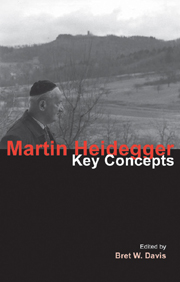Book contents
- Frontmatter
- Contents
- Contributors
- Acknowledgements
- Abbreviations
- Introduction: key concepts in Heidegger's thinking of being
- 1 Hermeneutics of facticity
- 2 Phenomenology: Heidegger after Husserl and the Greeks
- 3 Dasein as being-in-the-world
- 4 Care and authenticity
- 5 Being and time
- 6 The turn
- 7 Heidegger, National Socialism and the German People
- 8 Truth as alētheia and the clearing of beyng
- 9 The work of art
- 10 Ereignis: the event of appropriation
- 11 The history of being
- 12 Will and Gelassenheit
- 13 Ge-stell: enframing as the essence of technology
- 14 Language and poetry
- 15 The fourfold
- 16 Ontotheology and the question of god(s)
- 17 Heidegger on Christianity and divinity: a chronological compendium
- Chronology of Heidegger's life
- Bibliography
- Index
13 - Ge-stell: enframing as the essence of technology
- Frontmatter
- Contents
- Contributors
- Acknowledgements
- Abbreviations
- Introduction: key concepts in Heidegger's thinking of being
- 1 Hermeneutics of facticity
- 2 Phenomenology: Heidegger after Husserl and the Greeks
- 3 Dasein as being-in-the-world
- 4 Care and authenticity
- 5 Being and time
- 6 The turn
- 7 Heidegger, National Socialism and the German People
- 8 Truth as alētheia and the clearing of beyng
- 9 The work of art
- 10 Ereignis: the event of appropriation
- 11 The history of being
- 12 Will and Gelassenheit
- 13 Ge-stell: enframing as the essence of technology
- 14 Language and poetry
- 15 The fourfold
- 16 Ontotheology and the question of god(s)
- 17 Heidegger on Christianity and divinity: a chronological compendium
- Chronology of Heidegger's life
- Bibliography
- Index
Summary
Along with his greetings to the tenth annual meeting of the Heidegger Circle in the United States in 1976, Heidegger sent a short piece of writing, one of the very last by his hand. In it he raised again a question that by then had become perhaps the most persistent concern of the last decades of his life, namely the question of technology. By this he meant the need to understand and critically reflect on the sense and significance of the increased technologization of the world in modernity. He writes there that a world stamped by technology is also a world characterized by a forgetfulness of being, and he urges the participants to ponder its significance and effects (in Sallis 1978: 1). The most important concept in this context, and that by means of which he sought to capture the essential character of this momentous transformation, was that of Gestell, normally translated as “enframing”. Its common lexical meaning in German is “frame” or “rack”. But as a philosophical term it is a neologism, and Heidegger often hyphenates it as Ge-stell to indicate that it draws its meaning from a series of related concepts built around the root verb stellen (to place or put), such as herstellen (to produce) and vorstellen (to represent). It is also related to the word Gestalt, meaning figure or configuration. In his 1953 lecture, “The Question Concerning Technology”, one of the most widely read and discussed essays from his post-war period, he writes: “We now name the challenging claim that gathers man with a view to ordering the self-revealing as standingreserve: Ge-stell [enframing]” (BW 324 = VA 23).
- Type
- Chapter
- Information
- Martin HeideggerKey Concepts, pp. 183 - 194Publisher: Acumen PublishingPrint publication year: 2009

